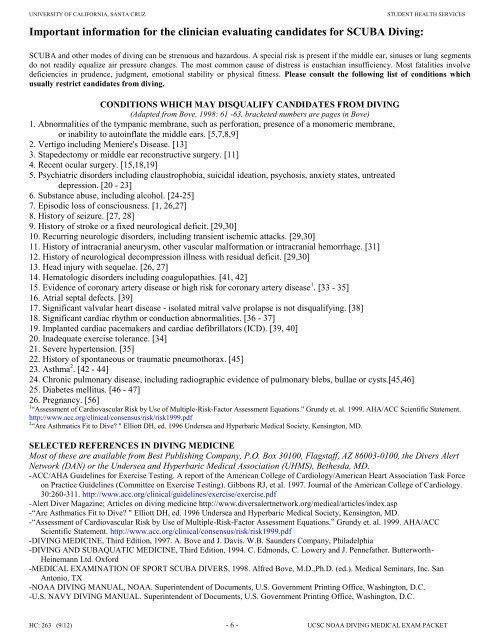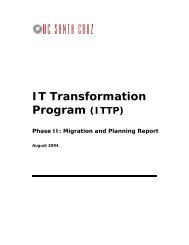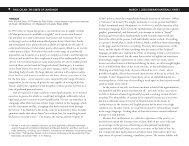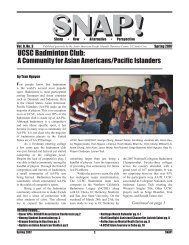OFF CAMPUS UCSC SCUBA DIVING MEDICAL EXAM PACKET
OFF CAMPUS UCSC SCUBA DIVING MEDICAL EXAM PACKET
OFF CAMPUS UCSC SCUBA DIVING MEDICAL EXAM PACKET
Create successful ePaper yourself
Turn your PDF publications into a flip-book with our unique Google optimized e-Paper software.
UNIVERSITY OF CALIFORNIA, SANTA CRUZ STUDENT HEALTH SERVICES<br />
Important information for the clinician evaluating candidates for <strong>SCUBA</strong> Diving:<br />
<strong>SCUBA</strong> and other modes of diving can be strenuous and hazardous. A special risk is present if the middle ear, sinuses or lung segments<br />
do not readily equalize air pressure changes. The most common cause of distress is eustachian insufficiency. Most fatalities involve<br />
deficiencies in prudence, judgment, emotional stability or physical fitness. Please consult the following list of conditions which<br />
usually restrict candidates from diving.<br />
CONDITIONS WHICH MAY DISQUALIFY CANDIDATES FROM <strong>DIVING</strong><br />
(Adapted from Bove, 1998: 61 -63, bracketed numbers are pages in Bove)<br />
1. Abnormalities of the tympanic membrane, such as perforation, presence of a monomeric membrane,<br />
or inability to autoinflate the middle ears. [5,7,8,9]<br />
2. Vertigo including Meniere's Disease. [13]<br />
3. Stapedectomy or middle ear reconstructive surgery. [11]<br />
4. Recent ocular surgery. [15,18,19]<br />
5. Psychiatric disorders including claustrophobia, suicidal ideation, psychosis, anxiety states, untreated<br />
depression. [20 - 23]<br />
6. Substance abuse, including alcohol. [24-25]<br />
7. Episodic loss of consciousness. [1, 26,27]<br />
8. History of seizure. [27, 28]<br />
9. History of stroke or a fixed neurological deficit. [29,30]<br />
10. Recurring neurologic disorders, including transient ischemic attacks. [29,30]<br />
11. History of intracranial aneurysm, other vascular malformation or intracranial hemorrhage. [31]<br />
12. History of neurological decompression illness with residual deficit. [29,30]<br />
13. Head injury with sequelae. [26, 27]<br />
14. Hematologic disorders including coagulopathies. [41, 42]<br />
15. Evidence of coronary artery disease or high risk for coronary artery disease 1 . [33 - 35]<br />
16. Atrial septal defects. [39]<br />
17. Significant valvular heart disease - isolated mitral valve prolapse is not disqualifying. [38]<br />
18. Significant cardiac rhythm or conduction abnormalities. [36 - 37]<br />
19. Implanted cardiac pacemakers and cardiac defibrillators (ICD). [39, 40]<br />
20. Inadequate exercise tolerance. [34]<br />
21. Severe hypertension. [35]<br />
22. History of spontaneous or traumatic pneumothorax. [45]<br />
23. Asthma 2 . [42 - 44]<br />
24. Chronic pulmonary disease, including radiographic evidence of pulmonary blebs, bullae or cysts.[45,46]<br />
25. Diabetes mellitus. [46 - 47]<br />
26. Pregnancy. [56]<br />
1<br />
“Assessment of Cardiovascular Risk by Use of Multiple-Risk-Factor Assessment Equations.” Grundy et. al. 1999. AHA/ACC Scientific Statement.<br />
http://www.acc.org/clinical/consensus/risk/risk1999.pdf<br />
2<br />
“Are Asthmatics Fit to Dive? " Elliott DH, ed. 1996 Undersea and Hyperbaric Medical Society, Kensington, MD.<br />
SELECTED REFERENCES IN <strong>DIVING</strong> MEDICINE<br />
Most of these are available from Best Publishing Company, P.O. Box 30100, Flagstaff, AZ 86003-0100, the Divers Alert<br />
Network (DAN) or the Undersea and Hyperbaric Medical Association (UHMS), Bethesda, MD.<br />
-ACC/AHA Guidelines for Exercise Testing. A report of the American College of Cardiology/American Heart Association Task Force<br />
on Practice Guidelines (Committee on Exercise Testing). Gibbons RJ, et al. 1997. Journal of the American College of Cardiology.<br />
30:260-311. http://www.acc.org/clinical/guidelines/exercise/exercise.pdf<br />
-Alert Diver Magazine; Articles on diving medicine http://www.diversalertnetwork.org/medical/articles/index.asp<br />
-“Are Asthmatics Fit to Dive? " Elliott DH, ed. 1996 Undersea and Hyperbaric Medical Society, Kensington, MD.<br />
-“Assessment of Cardiovascular Risk by Use of Multiple-Risk-Factor Assessment Equations.” Grundy et. al. 1999. AHA/ACC<br />
Scientific Statement. http://www.acc.org/clinical/consensus/risk/risk1999.pdf<br />
-<strong>DIVING</strong> MEDICINE, Third Edition, 1997. A. Bove and J. Davis. W.B. Saunders Company, Philadelphia<br />
-<strong>DIVING</strong> AND SUBAQUATIC MEDICINE, Third Edition, 1994. C. Edmonds, C. Lowery and J. Pennefather. Butterworth-<br />
Heinemann Ltd. Oxford<br />
-<strong>MEDICAL</strong> <strong>EXAM</strong>INATION OF SPORT <strong>SCUBA</strong> DIVERS, 1998. Alfred Bove, M.D.,Ph.D. (ed.). Medical Seminars, Inc. San<br />
Antonio, TX<br />
-NOAA <strong>DIVING</strong> MANUAL, NOAA. Superintendent of Documents, U.S. Government Printing Office, Washington, D.C.<br />
-U.S. NAVY <strong>DIVING</strong> MANUAL. Superintendent of Documents, U.S. Government Printing Office, Washington, D.C.<br />
HC: 263 (9/12) - 6 - <strong>UCSC</strong> NOAA <strong>DIVING</strong> <strong>MEDICAL</strong> <strong>EXAM</strong> <strong>PACKET</strong>





